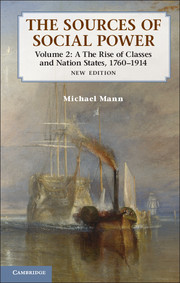Book contents
- Frontmatter
- Contents
- Preface to the new edition
- Preface
- 1 Introduction
- 2 Economic and ideological power relations
- 3 A theory of the modern state
- 4 The Industrial Revolution and old regime liberalism in Britain, 1760–1880
- 5 The American Revolution and the institutionalization of confederal capitalist liberalism
- 6 The French Revolution and the bourgeois nation
- 7 Conclusion to Chapters 4–6: The emergence of classes and nations
- 8 Geopolitics and international capitalism
- 9 Struggle over Germany: I. Prussia and authoritarian national capitalism
- 10 Struggle over Germany: II. Austria and confederal representation
- 11 The rise of the modern state: I. Quantitative data
- 12 The rise of the modern state: II. The autonomy of military power
- 13 The rise of the modern state: III. Bureaucratization
- 14 The rise of the modern state: IV. The expansion of civilian scope
- 15 The resistible rise of the British working class, 1815–1880
- 16 The middle-class nation
- 17 Class struggle in the Second Industrial Revolution, 1880–1914: I. Great Britain
- 18 Class struggle in the Second Industrial Revolution, 1880–1914: II. Comparative analysis of working-class movements
- 19 Class struggle in the Second Industrial Revolution, 1880–1914: III. The peasantry
- 20 Theoretical conclusions: Classes, states, nations, and the sources of social power
- 21 Empirical culmination – over the top: Geopolitics, class struggle, and World War I
- Appendix: Additional tables on state finances and state employment
- Index
- References
10 - Struggle over Germany: II. Austria and confederal representation
Published online by Cambridge University Press: 05 July 2013
- Frontmatter
- Contents
- Preface to the new edition
- Preface
- 1 Introduction
- 2 Economic and ideological power relations
- 3 A theory of the modern state
- 4 The Industrial Revolution and old regime liberalism in Britain, 1760–1880
- 5 The American Revolution and the institutionalization of confederal capitalist liberalism
- 6 The French Revolution and the bourgeois nation
- 7 Conclusion to Chapters 4–6: The emergence of classes and nations
- 8 Geopolitics and international capitalism
- 9 Struggle over Germany: I. Prussia and authoritarian national capitalism
- 10 Struggle over Germany: II. Austria and confederal representation
- 11 The rise of the modern state: I. Quantitative data
- 12 The rise of the modern state: II. The autonomy of military power
- 13 The rise of the modern state: III. Bureaucratization
- 14 The rise of the modern state: IV. The expansion of civilian scope
- 15 The resistible rise of the British working class, 1815–1880
- 16 The middle-class nation
- 17 Class struggle in the Second Industrial Revolution, 1880–1914: I. Great Britain
- 18 Class struggle in the Second Industrial Revolution, 1880–1914: II. Comparative analysis of working-class movements
- 19 Class struggle in the Second Industrial Revolution, 1880–1914: III. The peasantry
- 20 Theoretical conclusions: Classes, states, nations, and the sources of social power
- 21 Empirical culmination – over the top: Geopolitics, class struggle, and World War I
- Appendix: Additional tables on state finances and state employment
- Index
- References
Summary
What do we call it?
The political unit we are now discussing had a long and powerful history but no secure name. The most accurate designation over the longest period would be dynastic, not territorial: It was ruled from the thirteenth to the twentieth century by the Habsburg family. Throughout, the Habsburgs ruled hereditary territories in present-day Austria, their capital being Vienna. Hence “Austria” is an acceptable shorthand designation for this state. But it became a Great Power by virtue of massive feudal and dynastic expansion. From 1438 on, Habsburgs were elected continuously as Holy Roman (i.e., German) emperors, giving them a German leadership role. Marriage alliances coupled with fortunate deaths led to two extraordinary enlargements. In the west, Burgundy, Flanders, and Spain fell into Habsburg hands; in the east, the crowns of Bohemia, Hungary, and Croatia did the same. Most of the west could not be held, but the eastern gains of 1526–7 were retained until the end.
In 1760, the Habsburgs held these possessions (save for Silesia, lost to Prussia) plus Belgian Flanders and part of northern Italy. They also gained from Polish dismemberment and Ottoman decline. Most of the empire was now non-German, and in 1806, Francis I proclaimed himself emperor of Austria, abandoning his German imperial title (of which Bonaparte had just deprived him). But Hungary and Bohemia were kingdoms with their own institutions, including assemblies, called diets.
- Type
- Chapter
- Information
- The Sources of Social Power , pp. 330 - 357Publisher: Cambridge University PressPrint publication year: 2012



